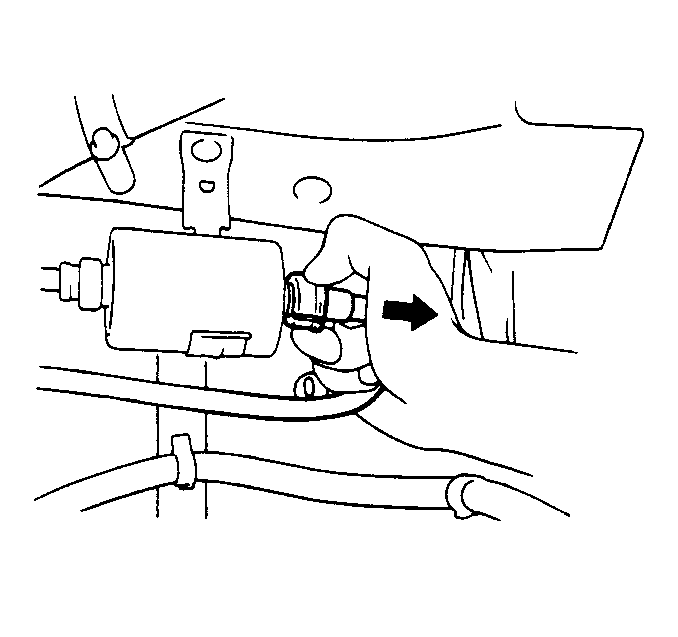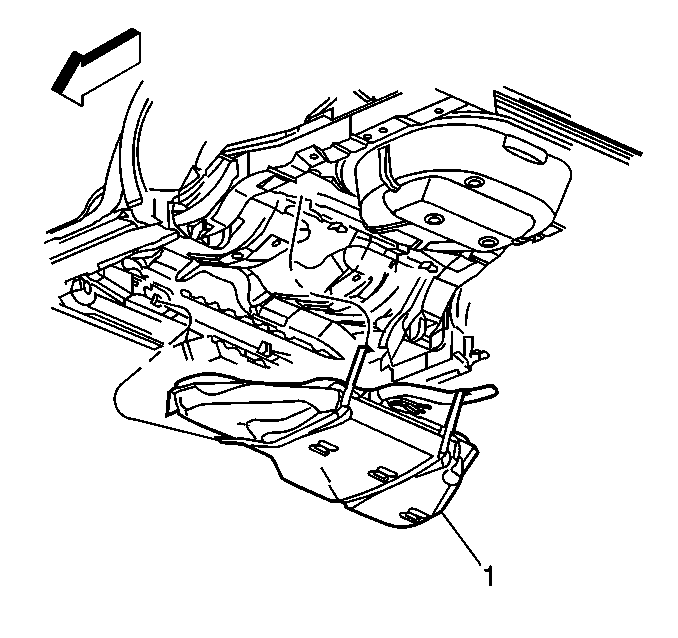Removal Procedure
- Relieve fuel system pressure.
- Drain the fuel tank. Refer to Fuel Tank Draining Procedure .
- Raise the vehicle.
- Disconnect the quick-connect fitting at the fuel filter. Refer toQuick Connect Fitting(s) Service (Plastic Collar) .
- Disconnect the quick connect fittings at the end of the fuel lines. Refer to Quick Connect Fitting(s) Service (Metal Collar) .
- Remove the muffler support bolts.
- Remove the exhaust rubber hangers. Allow exhaust system to rest on suspension support.
- Remove the hoses at tank from filler, vent and vapor pipes.
- With aid of an assistant, support fuel tank (1) and disconnect the two fuel tank retaining straps.
- Lower the fuel tank.
- Disconnect the fuel tank pressure sensor electrical connector.
- Disconnect the fuel sender electrical connector.
- Disconnect the EVAP line from the fuel sender.
- Remove the tank from the vehicle.
- Remove the fuel sender assembly from the tank. Refer to Fuel Sender Assembly Replacement .
Caution: Provide additional support when a vehicle is on a hoist in the following
ways:
• Before removing parts, support the opposite end. This helps prevent
the vehicle from slipping off. • Before removing major components, chain the vehicle frame to the
hoist pads at the same end as the removal. This helps avoid a tip-off.


Installation Procedure
- Reinstall the fuel sender assembly to tank. Refer to Fuel Sender Assembly Replacement .
- With the aid of an assistant, raise the fuel tank (1) to body.
- Reconnect the EVAP line to the fuel sender.
- Connect the fuel tank pressure sensor electrical connector.
- Connect the fuel tank sender electrical connector.
- Reinstall the fuel tank.
- Install the fuel tank retaining straps.
- Connect the hoses to filler, vent and vapor pipes.
- Reinstall the exhaust rubber hangers.
- Reinstall the muffler support bolts.
- Install the nylon fuel line and fuel filter quick-connect fittings. Refer toQuick Connect Fitting(s) Service (Plastic Collar) .
- Lower the vehicle.
- Refill the tank and reinstall the fuel fill cap.
- Connect the negative battery cable.
- Inspect for fuel leaks.

Important: Inspect all connectors for dirt and burrs. Clean or replace components/assemblies as required. Fuel line O-rings for cuts, nicks, swelling or distortion. Replace if necessary.
Notice: Use the correct fastener in the correct location. Replacement fasteners must be the correct part number for that application. Fasteners requiring replacement or fasteners requiring the use of thread locking compound or sealant are identified in the service procedure. Do not use paints, lubricants, or corrosion inhibitors on fasteners or fastener joint surfaces unless specified. These coatings affect fastener torque and joint clamping force and may damage the fastener. Use the correct tightening sequence and specifications when installing fasteners in order to avoid damage to parts and systems.
Tighten
Tighten the bolts to 35 N·m (26 lb ft).
Tighten
Tighten the bolt to 15 N·m (11 lb ft).
| 15.1. | Turn the ignition switch ON for 2 seconds. |
| 15.2. | Turn the ignition switch OFF for 10 seconds. |
| 15.3. | Turn the ignition switch ON. |
| 15.4. | Check for fuel leaks. |
